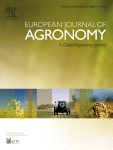Ver ítem
- xmlui.general.dspace_homeCentros Regionales y EEAsCentro Regional Santa FeEEA OliverosArtículos científicosxmlui.ArtifactBrowser.ItemViewer.trail
- Inicio
- Centros Regionales y EEAs
- Centro Regional Santa Fe
- EEA Oliveros
- Artículos científicos
- Ver ítem
Biological nitrogen fixation in field pea and vetch: Response to inoculation and residual effect on maize in the Pampean region
Resumen
Including legumes in winter, both as cover crop or for grain harvest, is recommended for avoiding long periods of bare fallow and supplying N for succeeding crops in the rotation. The aims of this study were to i) quantify the contribution of N derived from biological nitrogen fixation (N_BNF) in vetch (Vicia sativa L. or Vicia villosa L.) and field pea (Pisum sativum) in the Central Pampas region of Argentina, ii) evaluate the response to seed
[ver mas...]
Including legumes in winter, both as cover crop or for grain harvest, is recommended for avoiding long periods of bare fallow and supplying N for succeeding crops in the rotation. The aims of this study were to i) quantify the contribution of N derived from biological nitrogen fixation (N_BNF) in vetch (Vicia sativa L. or Vicia villosa L.) and field pea (Pisum sativum) in the Central Pampas region of Argentina, ii) evaluate the response to seed inoculation in terms of %N derived from air (%Ndfa), biomass production and N_BNF in both crops and iii) determine grain yield response to nitrogen fertilization of maize (Zea mays L.) sown after field pea and vetch with and without inoculation. %Ndfa was assessed in 16 experimental sites using the natural 15N abundance method. Response to inoculation in vetch and field pea and the residual effects on the following maize was evaluated during two years. On average, 60 % of N demand of vetch and field pea was met by BNF. Seed inoculation increased %Ndfa in field pea and vetch, and a positive impact on aboveground biomass and N_BFN was observed in vetch. Maize yield did not respond to N fertilization when planted after inoculated vetch, and the largest responses to N fertilization were observed when vetch and field pea were not inoculated. Legume inoculation had a strong impact at the system level, especially in fields that vetch or field pea was not previously cultivated, reducing the economic optimal nitrogen fertilizer rate in the succeeding maize.
[Cerrar]

Autor
Fuente
European Journal of Agronomy 115 : 126016 (2020)
Fecha
2020
Editorial
Elsevier
ISSN
1161-0301
1873-7331
1873-7331
Documentos Relacionados
Formato
pdf
Tipo de documento
artículo
Proyectos
(ver más)
INTA/PNCYO-1127033/AR./Manejo nutricional de cereales y oleaginosas para la intensificación sustentable de los sistemas productivos
Palabras Claves
Derechos de acceso
Restringido
 Excepto donde se diga explicitamente, este item se publica bajo la siguiente descripción: Creative Commons Attribution-NonCommercial-ShareAlike 2.5 Unported (CC BY-NC-SA 2.5)
Excepto donde se diga explicitamente, este item se publica bajo la siguiente descripción: Creative Commons Attribution-NonCommercial-ShareAlike 2.5 Unported (CC BY-NC-SA 2.5)

